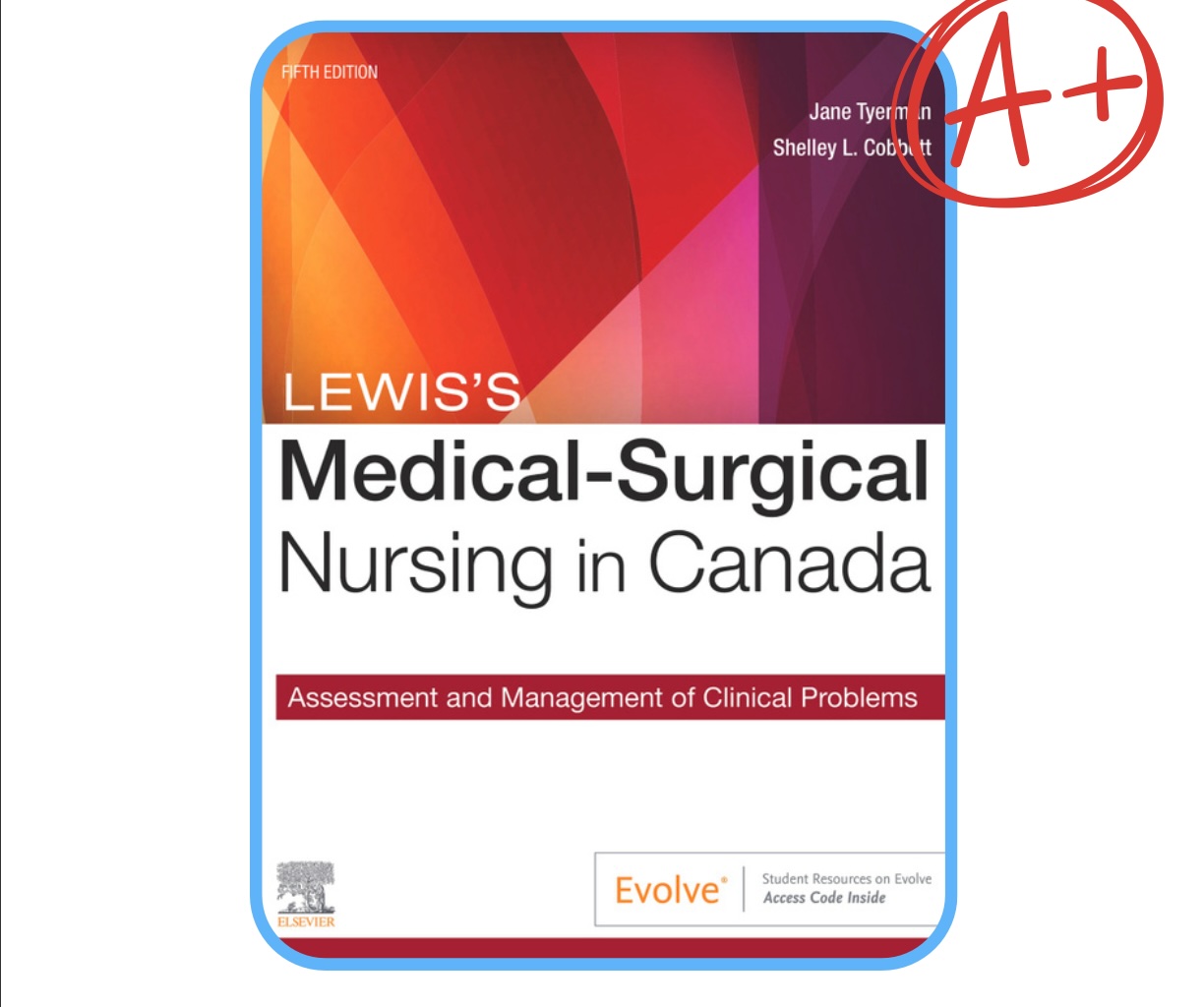Medical Surgical Nursing 5th Edition Lewis's Test Bank
Course
Business Law
Subject
Nursing
Category
Interview
Pages
652
Uploaded By
ATIPROS
Chapter 01: Introduction to Medical-Surgical Nursing Practice in Canada
Tyerman: Lewis’s Medical-Surgical Nursing in Canada, 5th Edition
MULTIPLE CHOICE
1. The nurse is caring for a patient with a new diagnosis of pneumonia and explains to the patient that together they will plan the patient’s care and set goals for discharge. The patient asks, “How is that different from what the doctor does?” Which response by the nurse is most appropriate?
a. “The role of the nurse is to administer medications and other treatments prescribed by your doctor.”
b. “The nurse’s job is to help the doctor by collecting data and communicating when there are problems.”
c. “Nurses perform many of the procedures done by physicians, but nurses are here in the hospital for a longer time than doctors.”
d. “In addition to caring for you while you are sick, the nurses will assist you to develop an individualized plan to maintain your health.”
ANS: D
This response is consistent with the Canadian Nurses Association (CNA) definition of nursing. Registered nurses are self-regulated health care professionals who work autonomously and in collaboration with others. RNs enable individuals, families, groups, communities and populations to achieve their optimal level of health. RNs coordinate health care, deliver direct services, and support patients in their self-care decisions and actions in situations of health, illness, injury, and disability in all stages of life. The other responses describe some of the dependent and collaborative functions of the nursing role but do not accurately describe the nurse’s role in the health care system. DIF: Cognitive Level: Comprehension TOP: Nursing Process: Implementation MSC: NCLEX: Safe and Effective Care Environment
2. When caring for patients using evidence-informed practice, which of the following does the nurse use?
a. Clinical judgement based on experience
b. Evidence from a clinical research study
c. The best available evidence to guide clinical expertise
d. Evaluation of data showing that the patient outcomes are met
ANS: C
Evidence-informed nursing practice is a continuous interactive process involving the explicit,
conscientious, and judicious consideration of the best available evidence to provide care. Four primary elements are: (a) clinical state, setting, and circumstances; (b) patient preferences and actions; (c) best research evidence, and (d) health care resources. Clinical judgement based on the nurse’s clinical experience is part of EIP, but clinical decision making also should incorporate current research and research-based guidelines. Evidence from one clinical research study does not provide an adequate substantiation for interventions. Evaluation of patient outcomes is important, but interventions should be based on research from randomized control studies with a large number of subjects.
DIF: Cognitive Level: Comprehension TOP: Nursing Process: PlanningMSC: NCLEX: Safe and Effective Care Environment
3. Which of the following best explains the nurse’s primary use of the nursing process when
providing care to patients?
a. To explain nursing interventions to other health care professionals
b. As a problem-solving tool to identify and treat patients’ health care needs
c. As a scientific-based process of diagnosing the patient’s health care problems
d. To establish nursing theory that incorporates the biopsychosocial nature of humans
ANS: B
The nursing process is an assertive problem-solving approach to the identification and
treatment of patients’ problems. Diagnosis is only one phase of the nursing process. The
primary use of the nursing process is in patient care, not to establish nursing theory or explain
nursing interventions to other health care professionals.
DIF: Cognitive Level: Comprehension TOP: Nursing Process: Implementation
MSC: NCLEX: Safe and Effective Care Environment
4. The nurse is caring for a critically ill patient in the intensive care unit and plans an every-2-
hour turning schedule to prevent skin breakdown. Which type of nursing function is
demonstrated with this turning schedule?
a. Dependent
b. Cooperative
c. Independent
d. Collaborative
ANS: D
When implementing collaborative nursing actions, the nurse is responsible primarily for monitoring for complications of acute illness or providing care to prevent or treat complications. Independent nursing actions are focused on health promotion, illness prevention, and patient advocacy. A dependent action would require a physician order to implement. Cooperative nursing functions are not described as one of the formal nursing functions.
DIF: Cognitive Level: Application TOP: Nursing Process: Implementation
MSC: NCLEX: Safe and Effective Care Environment
5. The nurse is caring for a patient who has been admitted to the hospital for surgery and tells the nurse, “I do not feel right about leaving my children with my neighbour.” Which action should the nurse take next?
a. Reassure the patient that these feelings are common for parents.
b. Have the patient call the children to ensure that they are doing well.
c. Call the neighbour to determine whether adequate childcare is being provided.
d. Gather more data about the patient’s feelings about the childcare arrangements.
ANS: D
Since a complete assessment is necessary in order to identify a problem and choose an appropriate intervention, the nurse’s first action should be to obtain more information. The other actions may be appropriate, but more assessment is needed before the best intervention can be chosen. DIF: Cognitive Level: Application TOP: Nursing Process: Assessment
Preview 3 out of 652 Pages



Download all 652 pages for $ 20.00
Reviews (0)
$20.00
